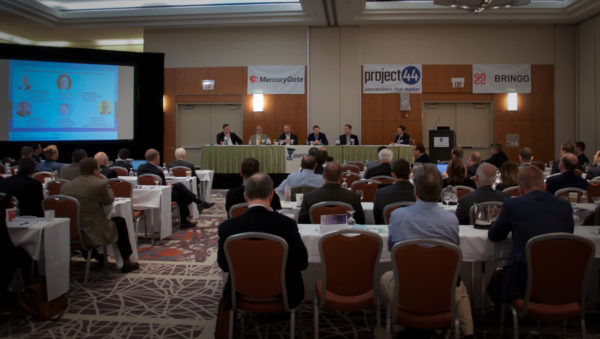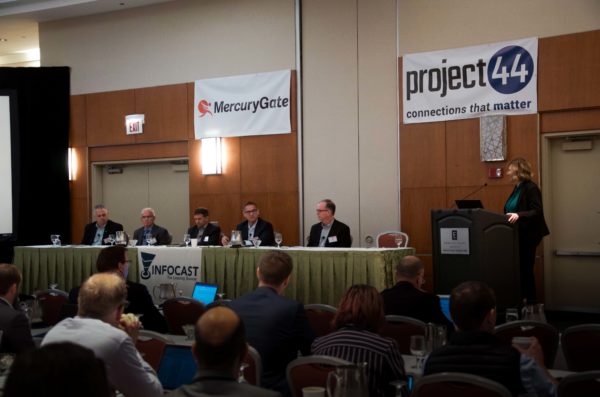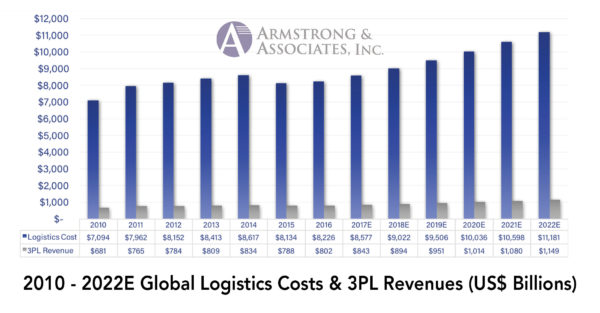Key Takeaways from the 3PL Value Creation Chicago Summit 2017
In October 2017, third-party logistics, technology, and investment leaders convened at Armstrong & Associates’ 3PL Value Creation Summit in Chicago to discuss trends in the $802.2 billion global 3PL market. For those who missed this year’s Summit, A&A collected a summary of major trends.
Within the major third-party logistics (3PL) segments, A&A expects to see solid growth amidst a changing environment. Domestic transportation management providers must grapple with surging spot market rates, and the electronic logging device (ELD) mandate may exacerbate the driver shortage. Capacity is the indicator to watch in value-added warehousing, as e-commerce drives stock keeping unit (SKU) proliferation. The rapidly changing international transportation management/freight forwarding industry has reason for optimism in 2018 as cross-border opportunities grow in key global markets. Company leaders are taking advantage of technology solutions, from warehousing robotics to application program interfaces (APIs) to digital freight matching apps.
With 2016 global e-commerce 3PL revenues of $40.6 billion, discussion of e-commerce logistics materialized in most panels throughout the three-day summit. The impacts are wide-ranging, from network redistribution to the increased demand for last mile fulfillment, parcel delivery, warehousing space, and tracking technology. E-commerce will be a significant game-changer for years to come—A&A expects e-commerce 3PL revenues to have a compound annual growth rate (CAGR) of 15.7% through 2020—and all facets of logistics will continue to be transformed. For a deep-dive analysis, keep an eye out for A&A’s upcoming global e-commerce logistics report, which will be released in early 2018.

More key takeaways are summarized below:
Global 3PL Trends
- Global logistics costs were $8.2 trillion in 2016. 3PL revenues represent about 10% of logistics costs, at $802.2 billion.
- Regional growth was noted for China, Mexico, Vietnam, Southeast Asia, and India. 3PL revenue in China is nearly on par with U.S. 3PL revenue, and China is projected to surpass the U.S. next year.
- Tightening environmental regulations in China are resulting in a manufacturing and supply chain shift to other Asian countries, particularly Vietnam. The relationship is somewhat analogous to that of the U.S. and Mexico, complete with regulatory hurdles.
- Growth industries include Automotive, Pharmaceuticals, E-commerce Retail, Food and Beverage, Consumer Packaged Goods, and Chemicals.
- Global e-commerce logistics costs were $392.2 billion in 2016, with a 16.3% CAGR expected through 2020. 3PL revenues were $40.6 billion, with a CAGR of 15.7% expected through 2020. CAGRs of that magnitude haven’t been seen in the 3PL market for some time, making e-commerce a significant growth driver.
- The automotive industry in Mexico continues to drive cross-border activity. Last year, automotive investment in Mexico exceeded that of any other country, and about 70% of automobiles made in Mexico come into the United States. There are tremendous volumes of auto parts from the central states into Mexico. The complexity of cross-border logistics rewards the handful of companies that have technology and operational expertise to do it well.
Mergers and Acquisitions
- Federal policies, growing consumer spending, wage inflation, and national growth are all increasing optimism for strategic buyers and private equity investors.
- It continues to be a seller-friendly market. Growth is a top driver of company valuation potential. Companies that plan to sell need a proper owner exit strategy and need to stage the company for the optimal value.
- Larger mergers are in the high velocity fulfillment e-commerce area, but there are also many opportunities in the mid-market space. Regionalization of distribution centers and the need to get products to the doorstep are leading to activity within regional parcel delivery and last mile companies.
- Strategic partners are looking for smaller, niche targets within core verticals or with strong existing customer concentration. Strategic partners from outside the U.S. are on the rise.
Innovation and Technology
- Innovation is growing company-wide within 3PL organizations. Some have invested in fully dedicated innovation labs or teams. Others have shifted company culture to empower all employees to quickly anticipate and address customer demands.
- Labor costs are up and availability is down, not just in the U.S., but across the board. The combined challenges of labor costs and e-commerce growth have made technology investments – such as improved warehouse management systems, robotics, cobotics, artificial intelligence, and machine learning – more attractive.
- Solutions coming on to the market include warehousing robotics to address repetitive activities, APIs for instantaneous and rich data flow, yard management software for inventory visibility, and back-office solutions such as document management.
- Other automatable tasks include telematics, load matching, data sharing using different decision support tools, and back-office work.
- Machine learning could be as impactful on the economy as the Industrial Revolution, with a leap in productivity as machines complete automated tasks while humans work with judgment cases. Good candidates for machine learning include pricing, routing, document matching, and load matching.
- We will see incremental changes towards autonomous vehicles. Platooning is likely to arrive before autonomous trucks.

Value-Added Warehousing and Distribution
- Within warehousing, capacity is the key performance indicator (KPI) to watch right now, and most facilities build 85–90% capacity into pricing. Many large customers are trying to pack more inventory into their existing footprint, and low interest rates have allowed customers to grow inventories at low carrying costs.
- Warehousing space utilization is tight, perhaps at an all-time high, at least partly due to e-commerce and increased freight from the Panama Canal expansion.
- E-commerce is driving SKU proliferation and a shift of warehousing closer to the end customer.
- Customers have the expectation that 3PL providers are the experts and should proactively identify and offer innovations. Robotics is a hot topic, but innovation comes in a variety of forms such as increased data availability to customers, automated guided carts and vehicles that are finally affordable, Six Sigma operations to meet higher omni-channel customer expectations, and continuous improvement projects.
International Transportation Management/Freight Forwarding
- Freight forwarding is riding tailwinds into 2018. The days of cargo growth being double gross domestic product (GDP) growth are over, but there’s reason for cautious optimism. The European Union is recovering, Japan is seeing robust growth, and China is on track for 6.5%+ GDP growth. Key indices in the U.S. are holding, and consumer confidence is high. Cross-border e-commerce is changing daily, and is an area of opportunity. Trans-Pacific Partnership (TPP) leadership and North American Free Trade Agreement (NAFTA) negotiations are still question marks. There is some worry about alliances, overcapacity, and another Hanjin-type scenario.
- The freight forwarding industry has seen more change in the last five years than in the prior 15, as a result of retail, automotive, cross-border, and technology shifts. Customer demands are changing with a particular need for tech-enabled omni-channel solutions. The flow of goods is also changing, resulting in network shifts, and delivery speed expectations are driving a move from ocean to air.
- Despite a shift from ocean to air, new large ocean carriers are coming on to the market, resulting in excess capacity. Meanwhile, no new air freighters have entered the market since 2012.

Transportation Management
- E-commerce is driving parcel and last mile growth.
- Shippers want visibility and tools that allow 3PL providers and shippers to jointly manage data.
- The ELD mandate may further impact driver capacity. Larger companies already have ELDs, but smaller companies will take time to adjust. The driver pool will shrink even further; Owner-Operator Independent Drivers Association (OOIDA) membership will decrease an estimated 8–10%. The reduction of truck drivers will increase driver wages and continue to squeeze freight broker margins, finally leading to greater industry consolidation.
- Carriers using digital freight matching (DFM) apps are looking for loads, freight brokers are looking for trucks, and shippers focus on price and service; DFM apps should be focused on these activities. Extra features are much lower priority, but DFM apps should also offer quick onboarding, document management, integrated tracking, payment, settlement, visibility, and integration.



